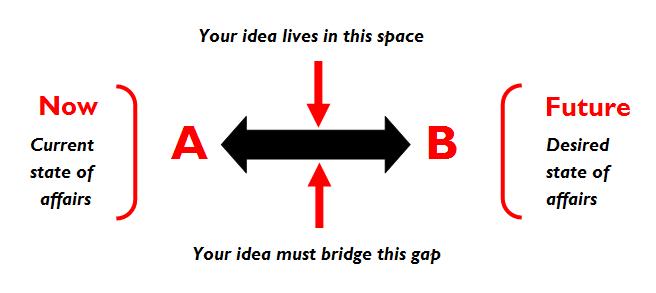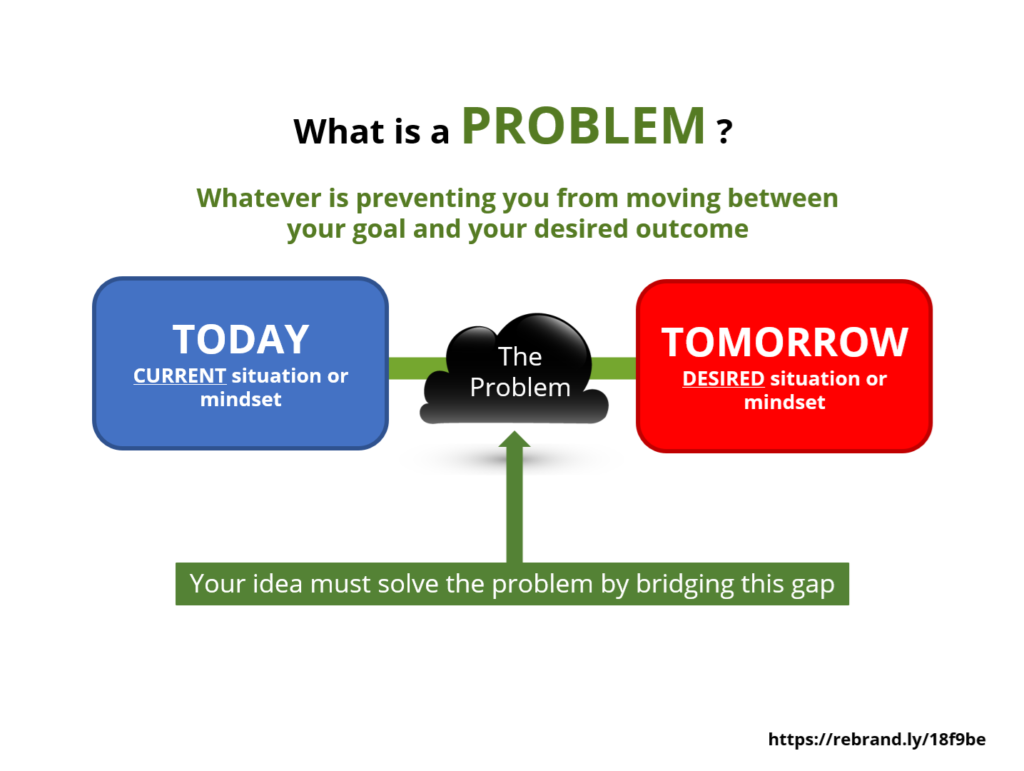So much of creativity – if not business overall – is understanding the problem enough to be able to eliminate it. And if not get rid of it, then either to minimise or put it into context.
One of the best articles I’ve read on problems and problem solving is the The Concept of a Problem by Gene Agre. In it, he defines a problem as The gap between the current state of affairs and the desired state of affairs.
Shown in the picture (right), the current state of affairs is A, the present or today.
The desired state of affairs is B, the future or the outcome we hope to achieve.
Taking his chart a step further toward communications strategy planning, problem solving or design thinking, Point A is what the target audience thinks and behaves today. This is a result of their history, experience, expectations and background in relation to a company, reputation or product.
Point B is what we want the target audience to think, believe or act. Notice that for either Today/Current or Tomorrow/Desired, the problem is one of two things:
- Mindset (the problem is inside your head, or you are the problem), or the
- Situation (the problem that’s outside of your head, but one that could have been created by you.)
In other words, know which type of problem you’re solving.
As a whole point to this entire topic, make sure you’re solving the right problem.
Enough of my soapbox, moving on.
The Problem Solving Matrix
To understanding and solve a problem with creative thinking, it’s often helpful to understand what stage you are at in the problem-solving cycle.
In one of the best books on creative thinking – Creative Thinking in the Decision and Management Sciences – author James Evans uses a simple chart to explain how problem solving occurs.
Working on a matrix, the left side of the chart is the current state of affairs (or “Point A”), and the top is desired state of affairs (or Point B). Both sides are divided into two categories – Known and Unknown – giving us the four levels of problem knowledge.
- In Box 4, you don’t know what the problem is (or may not be aware of the problem) and you don’t know what plan or action to pursue.
- In Box 3, you know what the problem is, but don’t know what plan or action to pursue.
- In Box 2, you don’t know what the problem is, but you (somehow) have already generated an idea or have created a plan of action.
- In Box 1, you know what the problem is and what to do.
To effectively solve a problem, you have to be in, or more to Box 1. You can’t solve a problem from any other spot, or if you do, you somehow have articulated the problem and/or developed a creative solution – which means you’ve moved to Box 1 without realising it.
How many times have you tried to solve a problem before moving to Box 1?
Or, how many times have you been in the dangerous position of Box 2? (“I don’t know what the problem is, but I have an idea!”)
If this topic interests you, check out the other posts on Problem Solving.
What tools do you use to understand problem? Please add your thoughts and comments below.





No comment yet, add your voice below!